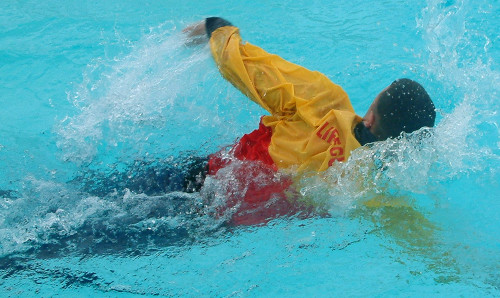Open Water Swimming Safety
Open water swimming is a never ending adventure. There is a freedom and challenge to open water swimming which just can't be experienced in the pool. However, it is important to stay safe.
Even the most seasoned of open water swimmers should read through this advice and follows it carefully, so you can enjoy the beauty of our natural surroundings safely. Not knowing the temperature of the water or how strong the current is could lead to swimmers struggling and in need of emergency help.
Lifeguarded Beaches
Lifeguards gladly give useful advice and assistance. They know the area, currents, water temperature and can give you tips on equipment and clothing. Ask them if there are any conditions, such as rip currents or other hazards, that you should be aware of before swimming in the open ocean. Tell the lifeguards, or someone else, where you are going and when you expect to be back, so they'll keep an eye on you. Maybe take a waterproof mobile phone with you. It can also log your gps trail for later trek analysis.
Some people rush to get into open water without proceeding with caution and understanding the potential life-threatening implications.
Open water sites, including beaches, are not always supervised.
With no one to help you if you get in trouble, emergency services may not be able to get to you in time.
If you are not used to swimming in open water, we strongly urge you to do so under supervision and guidance.
Never Swim Alone
If there is nobody on the beach, definitely don’t go into the water. Some people had to be rescued who had jumped in the water by themselves, didn’t know the conditions and then started to get hypothermic out in the sea. Going alone is actually not a mistake new swimmers commonly make, because most are too scared of open water to head out on their own.
Always go with other swimmers. Swim in a group of likeminded people or friends, who have the same love for the sport and are all aiming for the same kind of fun. One of them should be a qualified lifeguard. As a minimum have a safety spotter on the shore.
An experienced group can help you navigate any conditions and provide local knowledge.
But even if you don’t have a whole group, you should always have at least one swim buddy or someone in a boat with you.

Be Seen in Bright Clothes
Swimmers may be able to see boaters, but boaters may struggle to see swimmers, or not see them at all. A collision with any boat can be fatal.
Wear bright swimming clothes. A thin and lightweight red and yellow top is easy to swim in. It can also keep you warmer and provide sunburn protection.
Alternatively you could tow a bright orange float, but it maybe more cumbersome than swimming in clothes, reducing your freedom to move due to the tether.
You decide.
Be Mindful
Avoid mooring areas, marinas and jetties used by boats, ferry routes and boating channels. Be aware that boaters may be in any area of the lake at any time of day or night. Only swim when weather conditions are suitable. Remember they can change quickly.
Rescue
Hopefully this isn't something you will need,
but should you find yourself in difficulty in the deep water just roll yourself onto your back,
then put your hand in the air and wave to catch someone's attention.
This just keeps you in a nicely buoyant
and relaxed position
whilst making you obvious.
Safety Boat
If possible have a safety boat or support canoe when going into open water. It can help you if you start to struggle and others will see your safety boat before they see you.
Show to other water users that there are swimmers or divers in the water by displaying an Alpha flag on your boat.
Take turns so that the one in the boat also has a chance for a swim every now and then.
If you're skilful you can swap over in the middle of water.
One swimmer holds the boat and the boater jumps out.
Then the swimmer climbs into the boat while the boater holds it. Easy.
Start Small and Build Up
It's a good idea to go down to the water, talk to a local, walk along the edge, then go out a few feet. Then swim from one chosen point to another point, parallel to the shoreline. Paralleling the shore gives you a way out if you get in trouble and it gives you something to sight off. You can also walk down to your selected point and then swim back.
Getting comfortable in the water has to be done in stages.
This is particularly true if it is cold, because you have to acclimate and learn about the conditions you’re swimming in.
We suggest new swimmers do a very simple workout their first time, focusing on breathing, staying relaxed and being patient.
Don't Panic
Open water is a completely different environment from your pool. Often, visibility is limited in the water. You can’t see the bottom, there are no lane lines, there are waves and wind, plus sea animals.
Fear is one of the main challenges. For people who know how to swim, it is a bigger mental hurdle than physiological one. The mental-to-physical components are about 50-50.
For some of us, that fear causes us to panic, which is when things go badly wrong. That’s why you want to focus on breathing, being calm and taking your time. If you get stuck in a bad eddy or current, simply make sure you’re breathing and turn onto your back if you need to, instead of freaking out.
Panic can set in especially quick if the water is very cold.
Swimmers who aren’t used to cold temperatures will feel like they can’t breathe.
Using a thermal cap, ear plugs and a wetsuit are all key to being prepared, staying warm and avoiding panic,
but you also have to accept that it’ll be different than a pool no matter what you wear.
Pool Training
It may seem counterintuitive, but if you really want to get good at open water swimming, you’ll also want to swim in the pool more. No matter what kind of swimming you’re doing, you need the endurance. New swimmers can build up their swimming to a few times per week, with stroke instruction from a local masters group or coach. Swimming in similar clothes as you do in open water helps maintain the same training level. The better swimmer you are, the easier it’ll be in open water. You can simply learn to enjoy the swim.
